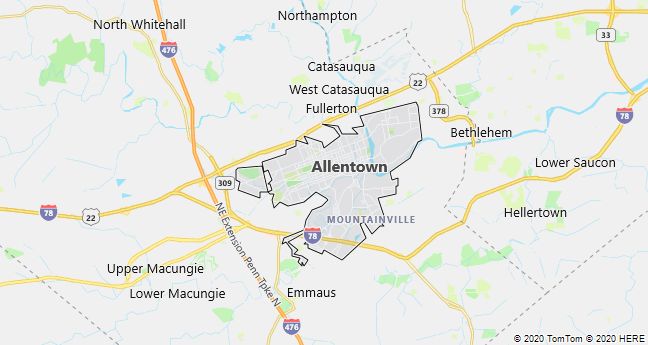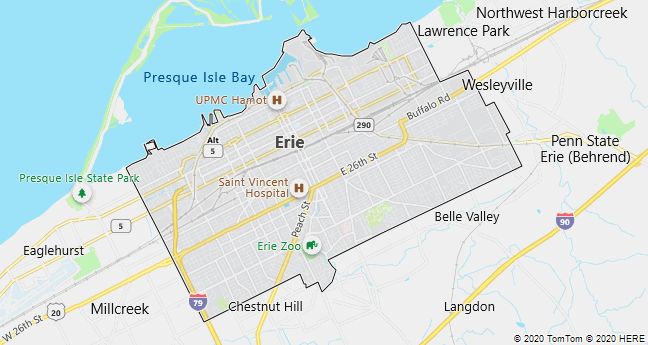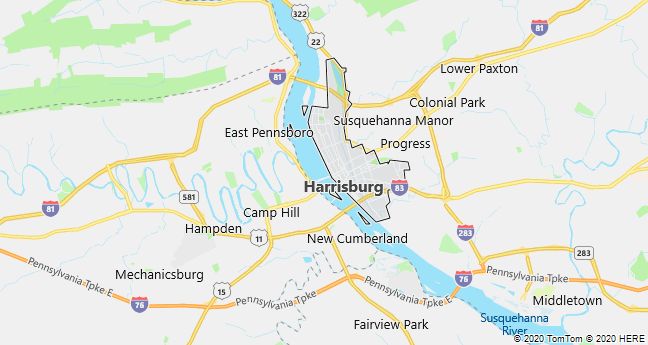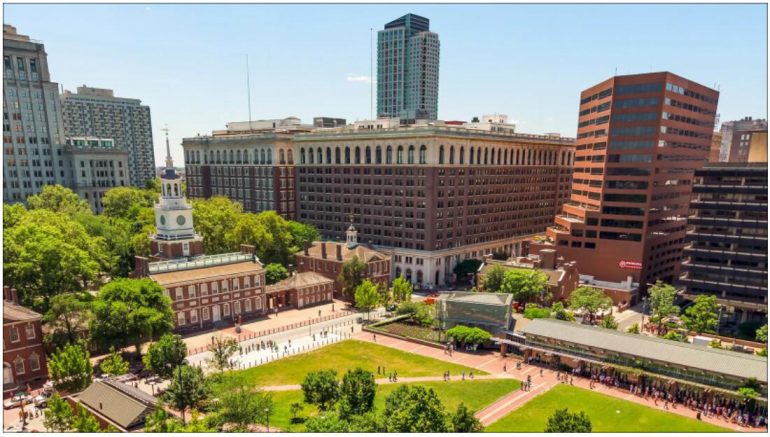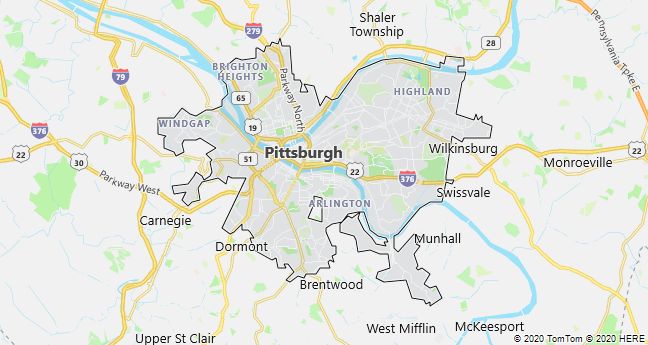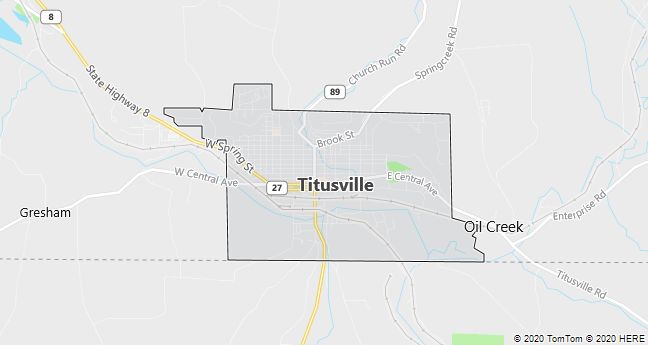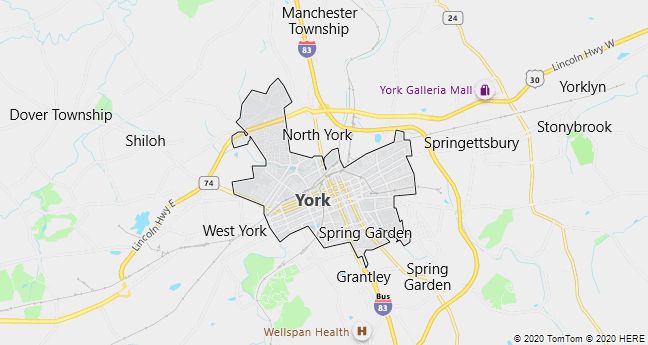Allentown
Allentown, an industrial city in eastern Pennsylvania, USA; 118,000 residents (2010). From the mid-1800’s. the city has been known for an extensive production of iron and cement, based on local ore and lime deposits. Allentown, nicknamed The Cement City, is still one of the largest cement producers in the United States, while the iron and steel industry has been in crisis since the 1960’s.
Erie
Erie, a port city on Lake Erie in Pennsylvania, USA; 101,800 residents (2010). After the construction of canals and railways in the mid-1800’s. the city gained a significant heavy industry and a central position in the transport of goods to and from the Great Lakes (grain, timber, coal and iron; later also oil and chemicals). The crisis of the steel industry in the 1960’s led to economic decline and emigration.
Harrisburg
Harrisburg, capital of the state of Pennsylvania, USA; 49,500 residents (2010). The city is a traffic hub on the Susquehanna River and, in addition to state administration, houses a number of higher education institutions and a number of industries. The beautiful parliament building (1906) is known by the dome, which is copied after St. Peter’s Church in Rome. At a nearby nuclear power plant in 1979, a serious accident occurred that had far-reaching implications for the a-power industry in the United States.
Philadelphia
Philadelphia, (after Philadelphia), largest city in Pennsylvania, USA, on the Delaware River; city population 1.5 million (2010), in the metropolitan area (extending into the neighboring states of New Jersey and Delaware) approximately 6 million residents.
The compact town center has undergone major changes since the 1950’s and appears as a mixture of modern high-rise buildings and well-preserved historic neighborhoods with a diamond-shaped street network from its foundation in 1682.
Here are a large number of memorials and public buildings that testify to the city’s importance to the nation’s independence and state formation in the late 1700’s. (Independence Hall, Liberty Bell, etc.). Furthermore, downtown is characterized by shopping and convention centers, banks and insurance companies as well as a wide-ranging cultural and entertainment life (jazz clubs, theaters, museums).
Apart from the US Mint coin factory, the industry has moved to the suburbs or is located along the harbor area, which is also home to the Philadelphia Naval Shipyard.
Port turnover is one of the largest in the United States, and among the very diverse industries is a high concentration of medical and biotechnology firms that have been attracted to the city’s traditional university hospitals and research institutes, such as Albert Einstein Medical Center, Thomas Jefferson University Hospital and Philadelphia College of Pharmacy and Science. Major and significant universities are the University of Pennsylvania, Drexel University and Temple University.
The population is of mixed ethnic origin with many European descendants and a black minority of 43% in the city, whose population has fallen by almost 600,000 since 1950. Income disparities are large and certain neighborhoods are heavily burdened despite extensive slum clearance and active efforts for to alleviate poverty and crime. A dark episode in the city’s history unfolded in 1985 when police bombed the headquarters of the black anarchist group MOVE, burning down 61 houses and leaving several hundred homeless.
Attractions include the Independence National Historical Park and the renovated Penn’s Landing harbor section, as well as Chinatown and several museums and art collections. Philadelphia Museum of Art in Fairmont Park on the Schuylkill River and American-Swedish Historical Museum.
History
The Swedish colony of New Sweden from the 1640’s was the earliest European settlement in the area, but the “city of charity” was laid out in 1682 by William Penn.
The religious tolerance of Pennsylvania led to a large immigration, and the city was with 28,000 residents in 1775 North America’s largest. Philadelphia was therefore also the natural center of the decisive events of the American Revolution 1775-83 and was the federal capital of the United States 1790-1800, just as until 1799 it was the capital of Pennsylvania.
Although Philadelphia subsequently lost its central political importance, it continued as one of America’s most important economic and trade centers, a position it has retained to this day.
Pittsburgh
Pittsburgh, a town in southwestern Pennsylvania, USA, at the confluence of the Allegheny and Monongahela rivers in the Ohio River; 305,700 residents (2004).
Pittsburgh calls itself The Renaissance City of America, which alludes to the transformation from a notorious and heavily polluted industrial city nicknamed “Hell without a Roof” to one of the country’s most attractive cities with a clean and tidy environment, low crime and a wide range of cultural activities. The renewal began after World War II and intensified after the steel crisis of the 1960’s and 1970’s, which hit the city hard, as from the mid-1800’s. had been the largest producer of iron and steel products in the United States. Factory closures and the loss of many jobs created a periodic large relocation, which since 1960 has almost halved the population of the city.
Pittsburgh is home to large industrial companies such as USX (until 1986 US Steel), Westinghouse Electric, PPG Industries, Alcoa, HJ Heinz and Penn Brewery, and it has become a center for biotechnology and computer software by virtue of University of Pittsburgh and Carnegie-Mellon University. The sights include the Andy Warhol Museum (1994) as well as numerous institutions, museums and collections named after the steel king Andrew Carnegie.
History
The French built Fort Duquesne in 1754, which the British conquered in 1758 and replaced it with Fort Pitt, around which the city of Pittsburgh was built in 1764. From approximately 1800 the growth of the town began to increase, thanks to its favorable location and a number of iron foundries, which later in the 1800-t. became the basis of heavy industry, primarily steel.
Centralia
Centralia, a former coal mining town in Pennsylvania, USA. Centralia was founded in 1865. In 1962, a fire started in a disused coal mine, which spread through the network of abandoned mines and has been burning underground ever since. From the 1980’s, it made the city largely uninhabitable due to the danger of carbon monoxide poisoning and landslides.
Throughout most of its history, Centralia had more than 2,000 residents, but in 2010 there were less than 10 left, and it is the intention that they should also move out of the city. Most buildings have been demolished.
Lancaster
Lancaster (Pennsylvania), city of Pennsylvania, USA, grdl. 1721; 59,300 residents (2010). It is located in the Pennsylvania Dutch countryside (derived from deutsch ‘German’), which is characterized by conservative, Protestant denominations of German descent (Amish, Mennonites, etc.). At the Farmers Museum and Landis Valley Museum, you can experience the traditional, pre-industrial way of life that is still practiced by the Amish. Lancaster was the capital of Pennsylvania 1799-1812.
Scranton
Scranton, town in the Appalachians of northeastern Pennsylvania, USA, 150 km NW of New York; 76,100 residents (2010). From the 1840’s to the 1950’s, the city was one of the country’s largest coal mining centers (anthracite) and an important industrial city with ironworks and textile industry. Since then, the ironworks have been closed down and the mining of anthracite has almost ceased, which has caused major economic and social problems. In recent years, however, we have succeeded in getting new companies to the city, which together with tourism have again created economic growth. Excursion destinations include the Lackawanna Coal Mine, Steamtown National Historic Site and nearby ski resorts.
Titusville
Titusville, a town in northwestern Pennsylvania, USA; 5601 residents (2010). On the outskirts of the city is the Drake Well Memorial Park, where Edwin Drake (1819-88) in 1859 initiated the world’s first productive oil drilling. The oil activities were finally abandoned with the closure of the last refinery in 1950.
York
York (Pennsylvania), city in southeastern Pennsylvania, USA, founded 1741; 43,700 residents (2010). Here, representatives of the 13 British colonies of North America founded the United States of America (USA) on 15.11.1777. The Harley-Davidson motorcycle factory is located in the city.
